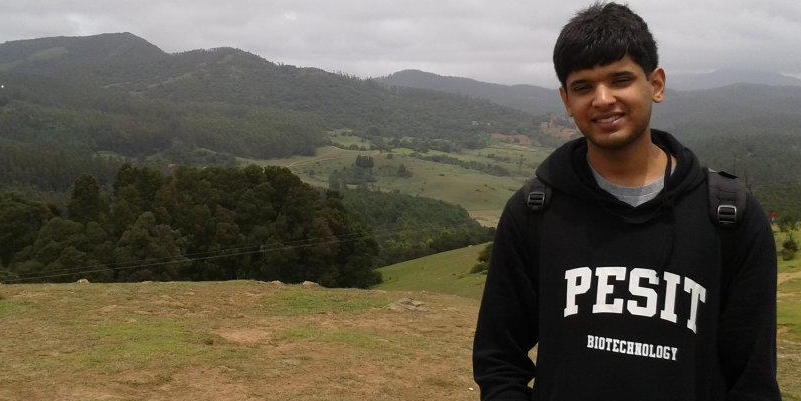Welcome to my Page
PhD Candidate, Haussler Lab
UC Santa Cruz Department of Biomolecular Engineering
UC Santa Cruz Genomics Institute
aarjunrao [at] soe [dot] ucsc [dot] edu

Welcome to my Page |
|
|
Arjun Arkal Rao PhD Candidate, Haussler Lab UC Santa Cruz Department of Biomolecular Engineering UC Santa Cruz Genomics Institute aarjunrao [at] soe [dot] ucsc [dot] edu |
 |
Home |
About Me |
Picture Gallery |
Publications |
Me as a person |
Contact Me |
I completed all my schooling at the Frank Anthony Public School located in Bangalore, India and graduated in March 2008. During my school years I participated in numerous inter- and intra-school debates and elocution competitions and even trained individuals from junior classes for the same. I was also a part of the schools Brass band and played the Circular Mellophone, a variant of the traditional French Horn.
I pursued my B.E. in Biotechnology at the PES Institute of Technoogy, Bangalore over the period of 2008-2012. During the course of my Bachelor's, I was appointed as the Cultural Secretary of the college and led the team which hosted our annual techno-cultural fest, Aatmatrisha.
In my second summer break, I interned at GANIT Labs in Bangalore, where I was first introduced to the world of Next Generation Sequencing. Under the mentorship of Dr. Swetansu Pattnaik, I worked on porting an R script for detectin of Copy Number Variations from Shotgun Sequencing Data [1] into the C programming language. The CNV-Seq tool used the read counts in contiguous static sliding windows of fixed length to detect CNVs from shotgun sequencing data. I attempted to modify the algorithm to utilize dynamic discontiguous windows to detect the same. This exposure to bioinformatics was when I decided to pursue it as my future career.
I maintained contact with Dr. Pattnaik over my third year of Engineering and was invited by him to intern at GANIT labs during my third summer break. My project during the period was to develop a computational tool for artificially inserting CNVs into genomic FASTA files with user defined frequency, range of lengths and copy number. The data generated by my program was used to validate a CNV detection tool developed at GANIT labs and due to my effort I was given authorship in the paper.
In my 4th year, I was expected to conduct 2 5-month projects and my first project was carried out at GANIT Labs under the joint guidance of Dr. Pattnaik and Mrs. Vaijayanthi Raghavan from PESIT. I modified the Single Nucleutide Polymorphism(SNP) and Short Insertion and Deletion (INDEL) simulating modules created by another Intern (Raghu Chandramohan) and combined it with my CNV simulating algorithm to produce a robust genetic variations simulation tool named SInC (Snvs, Indels n' Cnvs). To add to the variation simulation, I developed an Illumina paired-end read data simulation tool which can simulate synthetic paired end sequencing data from an input genome sequence with Illumina-like base quality scores in a short time using the C pthreads library (Available tools either could not simulate quality scores or would take a long time to generate data for the whole Human Genome). After my period at GANIT Labs ended, Saurabh Gupta (an employee at GANIT Labs) took up the responsibility of optimising the code and developing future modules for it. The read generation module was bundled into the SInC package and the paper has been submitted for peer review to a Major Journal. A preprint of the paper can be viewed here.
My second final-year project involved the detection and isolation of micro-organisms in soil samples expressing a high quantity of esterases. I worked in collaboration with Ms. Divyashree Kushnoor and Ms. Surabhi Devraj under the guidance of Dr. K.N. Shanti. We identified potential sources for microorganisms and cultivated them in selective media having only Tween-20 or glycerol as a carbon source. The organism showing best growth on the media was selected as a potential candidate for large scale esterase production. we conducted various microbial characterization tests to arrive at the conclusion that our organism was Pseudomonas aeruginosa. We isolated the secreted enzyme from a broth culture of P. aeruginosa containing cetrimide (which makes the broth selective for our organism) using Ammonium Sulphate extraction and found that interestingly, the enzyme does not precipitate in solution but instead aggregates and floats to the surface of the liquid surface in the form of a froth. The enzyme activity per unit volume of culture was calculated and reported in our final submission.
After graduation from PESIT, I worked for a year as a Junior Research Fellow at the Microbiology and Cell Biology Department at the Indian Institute of Science, Bangalore. My work in Dr. Kumar Somasundaram's Lab involved the detection of Fusion Genes in Glioblasitoma Multiforme . And additional bonus to working at IISc was that the facility was new to the field of bioinformatics and I gained the skills required to set up a new server machine running CentOS for the purpose of NGS analysis.
I am currently enrolled in the PhD Program in Biomedical Sciences and Engineering at the University of California, Santa Cruz with a focus on the Bioinformatics and Computational Biology learning track. As a part of my first year in the program, I am required to complete 3 6-week lab rotations in separate labs in order to get a grasp of the research occuring at the university.
Page Designed by Arjun Arkal RaoPage Last modified: November 1st, 2015. |